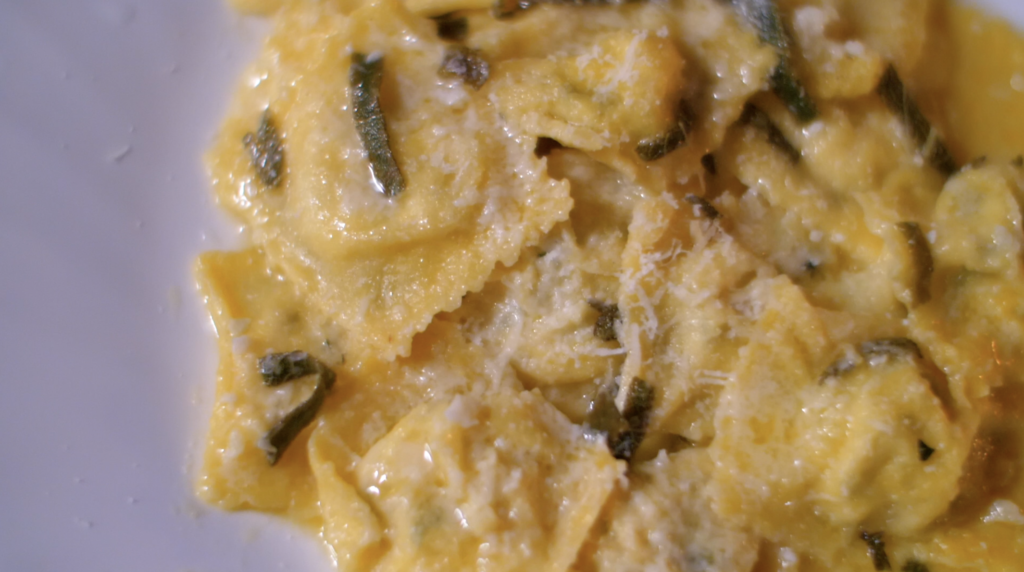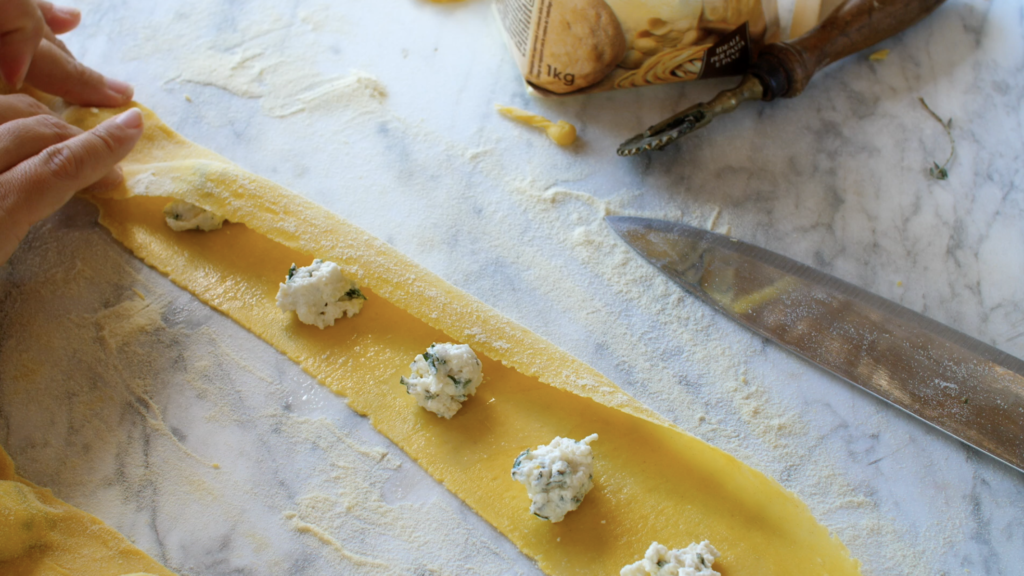A lot of recipes will tell you that ravioli are easy. However, I would disagree. They can be simple and the preparation time isn’t really that long but one small error can ruin all your work, leading amateur pasta-makers to give up completely. So I’ll try to add as many tips as I can so that your ravioli experience is a pleasure. I’m no expert but I have been making ravioli (and making mistakes) for many years.
This quantity serves four people if you’re serving sophisticated portions like in a fine dining restaurant, two people if you want hearty servings like in a trattoria (or seconds).

INGREDIENTS:
PASTA
2 cups 00 flour (this is important, you don’t want a coarse flour, you want a fine texture)
1 teaspoon fine salt
2 whole eggs
4 egg yolks
1/2 cup semolina for keeping your ravioli from sticking
FILLING (these quantities are approximate because you can vary them according to your preference)
300g ricotta (If you’re doing large ravioli with generous spoonfuls of filling, I would use about 400-500g)
20-40g grated parmesan
1 teaspoon salt (it’s a good idea to over-season your filling because the sauce with this recipe is not that salty and we have a lot of sweet and acidic flavours)
1 teaspoon pepper
a small bunch of your favourite fresh herbs (thyme, basil, parsley, oregano, sage, mint), finely chopped, to make approximately 1/4 cup
zest of 1 lemon
1 teaspoon ground nutmeg
SAUCE
2-3 tablespoons butter
3 tablespoons olive oil
1 garlic clove
2 tablespoons chopped sage
Juice from quarter of a lemon
extra Parmesan to serve

METHOD:
- Pour your flour onto a smooth non-porous work surface and mix in the salt with your fingertips.
- Make a well in the centre and crack in the two whole eggs and four egg yolks. Don’t worry if some of the egg runs out and down the sides. If you’re worried about it running off your bench and onto the floor, start whisking in the flour (as shown in the video) when you have half the eggs in to form a little paste and then add the remainder. As you’re whisking with the fork it may seem like your dough will never come together and you might fear your mixture is too dry. Wait, before adding water or olive oil because with this many eggs, the moisture will soon reveal itself. The other issue could be that it’s too sticky. It will stick to your fingers and seem unmanageable to begin with. That’s why I left in a shot of it sticking and looking quite rough in the beginning before I started kneading so you know that this is normal.
- Knead for about 10 minutes, turning the dough continually. If you’re finding it difficult, move to a different spot on the bench that is clean and free of sticky pasta and it should be much easier. You can sprinkle a little semolina, but I don’t usually find it necessary at this stage.
- It’s very important that you cover the dough airtight. I once covered my dough with only a tea towel and came back to find a hard crust around the edge, which is a pain to get rid of. Instead of plastic wrap, I like to use a Tupperware container or the biodegradable bags they make you weigh vegetables in (in Italy) that are too flimsy to hold rubbish and often have holes in them, which I can just knot to make the dough airtight. Leave the dough to rest and hydrate and let that flour absorb all the egg for at least an hour. It really changes the texture.
- Meanwhile, we can prepare the filling. If your ricotta seems quite wet, push it through a sieve first to eliminate any excess liquid. In a medium bowl, mix ricotta, salt, pepper, chopped herbs, nutmeg, lemon zest and grated Parmigiano cheese. Set aside in the fridge.
- TIMING. I find ricotta ravioli best cooked very soon after they’re made so think about this before you start rolling out your dough. Will your dining companion be ready to eat in 45 minutes to an hour? Sometimes if you leave ricotta-filled ravioli too long, they become soggy and difficult to lift from the tray. You will need to turn them after 15 minutes so the bottoms don’t absorb too much moisture from the filling. Now that I’ve warned you, let’s begin rolling. Cut one quarter of your dough and seal the remainder under a towel or a bowl. If using a pasta machine, start on the widest setting and fold it, doubling it onto itself before moving to a thinner setting. You may need to cut the strip when it becomes too long to handle. Just be sure to work fast because the second half strip waiting will start drying out.
- Once you have a delicate wide strip, sprinkle semolina on your work surface and you can spoon out the filling with two finger widths between each ricotta ball. But honestly, this is up to your preference. You may prefer to make just four big squares per person. All I would advise is that you leave sufficient space for getting your fingers in between each ricotta ball to squeeze out the air bubbles. And, of course, if you are doing the technique of folding one long wide strip in half, be sure to leave plenty of pasta to fold over. Otherwise, you can just put a second strip on top. The two alternative are shown in my video.
- Once you have your filling laid, brush a little water with a pastry brush (or just your finger) the lengths of the strip and also in between each ricotta ball. Don’t get too generous with the water or you will make the pasta too sticky.
- Now fold the pasta over and rest it lightly on the ricotta but don’t push it down at all. You want to start at one end and gradually cup each ricotta mound to push out air bubbles. This will mean that the top layer will shift its position slightly as you make your way down the line. Start by pressing the edge that is folded so the air can escape on the side that is cut. If there is too much air trapped in a raviolo, it could explode when in the hot water later.
- Now with a pasta cutter or a knife, cut down both sides (the folded and the cut edge). I do this because I find it really seals the ravioli from all directions. If you’ve found there is a little too much space between each raviolo, just cut out the excess pasta. It’s more elegant and pleasing to the palate, if you have a minimal border of pasta around each filling mound. If you’re worried about wasting the excess pasta, you could lay these scraps out on a tray with some semolina, let them dry out and use them in a minestrone soup for another recipe. Lay the finished ravioli on a tray with a generous amount of semolina. We’re so close to the finish line now – you don’t want them sticking to the tray because it’s impossible to save a ravioli with a hole in it.
- After 10-15 minutes, turn any finished ravioli so their bottoms don’t go soggy from the ricotta.
- Boil some water and add a decent amount of salt while we prepare the sauce.
- In a fry pan, gently cook the minced or finely chopping garlic in the butter, olive oil and sage. A word about the lemon juice. I love lemon in savoury dishes but Guido is not such a fan of too much lemon juice in sauces so you might want to add just a squeeze and then taste it before adding the whole juice of the quarter lemon.
- Cook the ravioli for only about a minute or until they float to the top. You don’t have to worry about them being undercooked. We will finish them off in the sauce where they cook more. Don’t tip them into a colander to drain because they’re so delicate they might break. I like to shift them into the fry pan with a large slotted spoon or tongs. Before you throw out that pasta water, take a tea cup of that lovely starchy water, which will thicken our sauce and help it adhere to the pasta.
- Now on a low to medium heat, agitate your pan in circles, swirling the ravioli gently and adding just enough of the pasta water to lightly coat the pasta – but not too much or you’ll dilute the sauce.
- Now turn off the heat and grate Parmesan over the whole pan. I like to place each raviolo individually on a plate and then with a spoon, drizzle a little of the sauce on top. Otherwise it will all splash and create mess. Also, you may have added too much pasta water, in which case, you don’t want your ravioli sitting on a plate in a soupy puddle. Top with pepper, a drizzle of olive oil and some extra cheese.